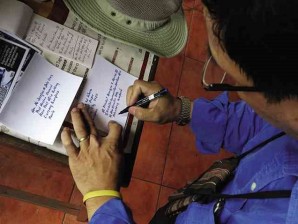
JOEL ARTHUR Tibaldo sends postcards to President Aquino and Postmaster General Josephine dela Cruz, the traditional way, to urge the conservation of Baguio’s old post office building. The advent of technology, symbolized by the smart phone next to Tibaldo, is being blamed for the slow death of traditional, or snail, mail. EV ESPIRITU/INQUIRER NORTHERN LUZON
BAGUIO CITY – A group of residents on Tuesday went to the city’s post office to send postcards, the traditional way, to President Benigno Aquino III and the postmaster general of the Philippine Postal Corp. (PhilPost).
The residents urged them to authorize the conservation of Baguio’s post office building before it is either privatized or abandoned.
The postcards feature an old photograph of Baguio’s original post office building that bears features of American colonial architecture.
Each card is labelled with the phrase, “Save Baguio City’s Post Office!” “Please support the proposal to have the Baguio Post Office declared a heritage site and [to be] converted into a postal museum,” it says.
The cards were designed by government employee Joel Arthur Tibaldo, who is also administrator of the Baguio Cinematheque. Tibaldo launched an online campaign to preserve the post office building.
“Post offices around the world are considered historical monuments because of their significant contribution to the human race, bridging people of various creeds and races in all four continents. But what we have here in Baguio is far from… a monument,” Tibaldo said.
Sections of the building were partitioned into stalls for rent to various enterprises. This is because postal operations in the summer capital have been housed at a modern building since 1992, sharing space with the Philippine Postal Savings Bank and the Department of Transportation and Communications, leaving the original facility idle.
In 2003, the local post office became the subject of a criminal investigation when authorities discovered that suspected treasure hunters had dug tunnels under the building.
Many of those who share Tibaldo’s campaign said the postal museum could house old letters and artifacts sent through the mail during Baguio’s early years, making it a part of the city’s heritage-building efforts since it celebrated its centennial in 2009.
However, few archival documents make references to the summer capital’s old post office when Baguio was built by the American colonial government.
Erlyn Alcantara, a researcher and archivist, said the post office may have been built in the 1920s, but an examination of photographs during that era may need to be done to pinpoint the period when it became an active government service.
The original Baguio post office stands on one of the prime properties of PhilPost, said Marc Laurente, Philpost spokesman.
In 2011, Philpost began an inventory of its property, hoping to develop some of the assets given the diminishing number of people who send letters through the traditional mail service, Laurente said. Philpost earned P138 million in 2012, he said.
“But PhilPost has not made any decision yet about the Baguio property,” he said. Vincent Cabreza, Inquirer Northern Luzon

